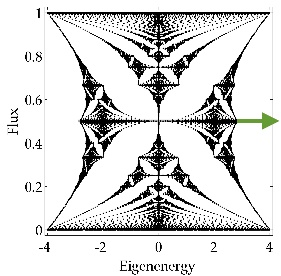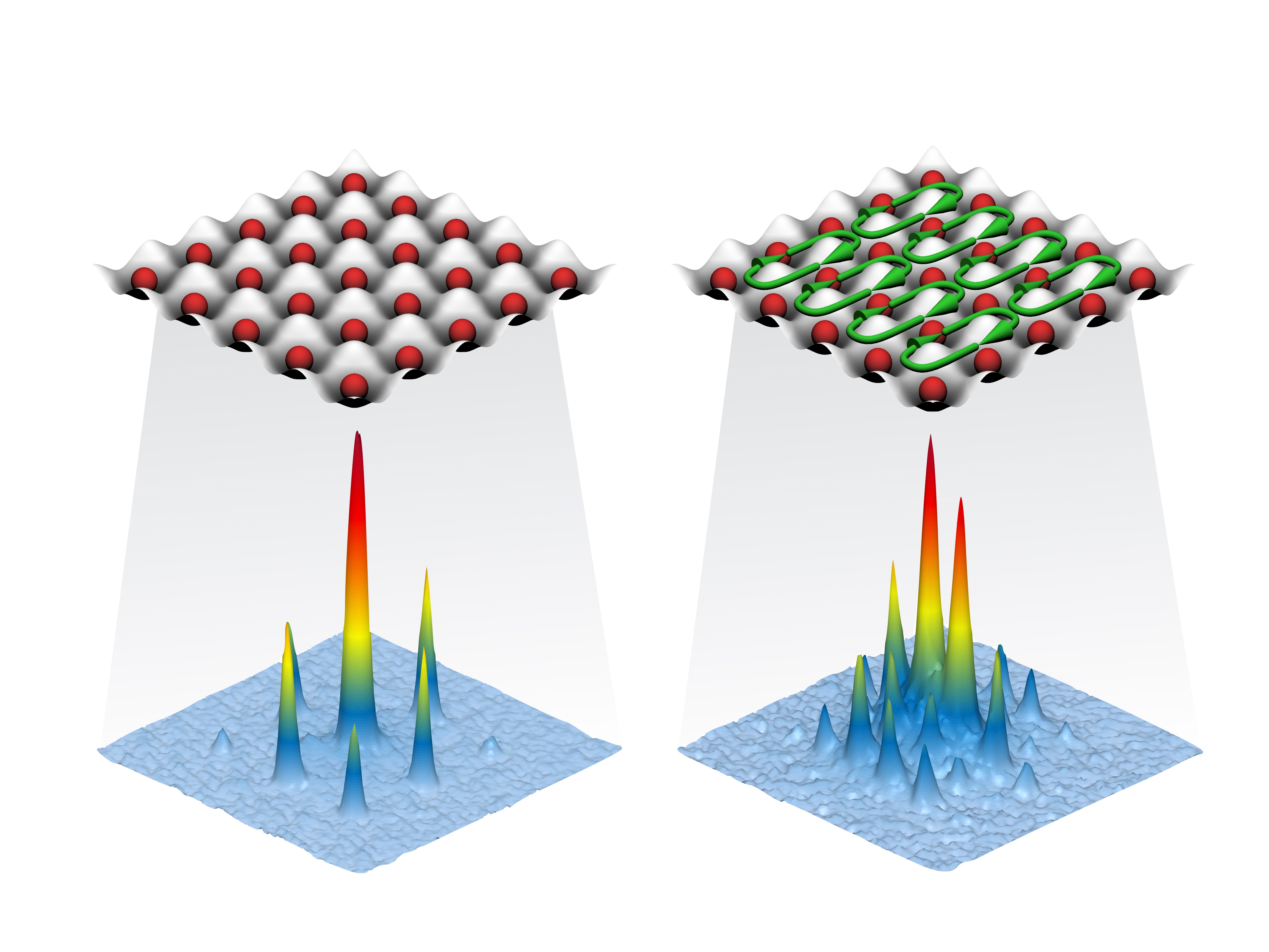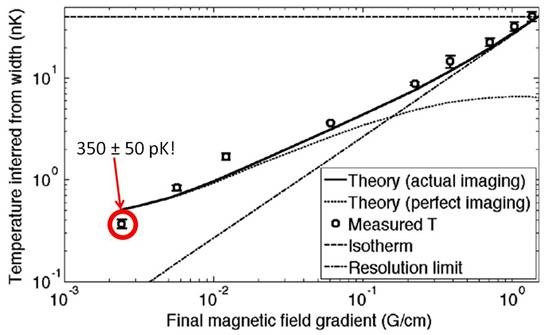Overview
One direction of our research is to create systems analogous to solids in condensed matter systems by using ultracold atoms in optical lattices. Major challenges we address with our research is cooling these gases to lower temperatures and probing the new states of matter we expect to find as new energy scales become accessible. To this end, we have pioneered the methods of demagnetization cooling and Bragg scattering for ultracold atoms in optical lattices.
Another exciting direction for our research is the possibility of creating states of matter that do not exist in the traditional condensed matter context. To this end, we are exploring the control offered via state-dependent lattices to manipulate and cool different spin states in the lattice.
Synthetic Magnetic Fields
How can neutral particles in a lattice be made to act like charged particles in a lattice with a magnetic field? Although they lack charge, neutral particles can experience effective magnetic fields through the magnetic vector potential, A, and its manifestation as a spatially varying phase of the wavefunction. Much recent work in atomic physics has focused on how to generate such fields through the Anaronov-Bohm effect and Berry's phase. Now, what happens when the length scale associated with this magnetic flux is comparable to the length scale of the underlying lattice? The answer is the fractal energy spectrum of Hofstadter's butterfly (below, left), encoded by the Harper-Hofstadter Hamiltonian. Using a uniformly tilted optical lattice and Raman-assisted tunneling, we have realized the Harper Hamiltonian with a scheme generalizable to arbitrarily high magnetic fields, check it out here!
An important challenge in such a driven many-body system is to keep the temperature low enough to probe the state of interest. We have recently succeeded in reducing the heating rate sufficiently to observe Bose-Einstein condensation (BEC) in such a system. This is the first observation of a superfluid BEC at such high magnetic fields and is interesting because the diffraction of a BEC directly reveals the lower translational symmetry of the vector potential than the magnetic field it describes. In addition, we demonstrate the ability to add strong interactions to the superfluid which constitutes an important step in realizing new phases of matter expected to appear with the combination of both strong interactions and high magnetic fields. Our work opens up an exciting new regime for realizing strongly correlated materials in ultracold atomic systems, stay tuned!
Spin-Orbit Coupling
The coupling of spin and motional degrees of freedom is an important interaction for understanding the physics of topological insulators and a subject of intense interest recently in the field of ultracold atoms. However, much of this work has been directed at using spin-changing Raman lasers to transfer the intrinsic spin-orbit coupling of an atom to it's motional degrees of freedom in a trap, which ultimately limits this schemes usefulness in studying many-body physics. We demonstrated that spin-orbit coupling does not require near-resonant Raman lasers and can be accomplished with spin-dependent Zeeman shifts and laser recoil momentum. In addition, our scheme corresponds to an Abelian gauge field completely diagonal in the spin degree of freedom!
Spin-Dependent Lattices
Many interesting states of matter, especially magnetic ones, contain spin correlations. At low enough temperatures (an active research frontier, see below...), the super-exchange interaction is thought (an active research frontier, again...) to give rise to spin correlations. But what if we could use the tricks of atomic physics to start with a low entropy state that already had spin correlations built in? To accomplish this we use a state-dependent lattice to enter a Mott insulating state. This configuration can then be adiabatically ramped to one where the spins share a lattice site simply by rotating the polarization of the retroreflected light.
This low-entropy, spin-correlated state is now an interesting starting point for testing the many-body physics of interacting spin systems. Stay tuned for results!
Bragg Scattering
How do you know if you have created a new state of matter or not? Often, a new state will be ordered in a way differently than the one you started in or react differently to perturbations - like ice versus liquid water or an insulator versus a conductor. We developed the technique of Bragg scattering for ultracold atoms in a lattice as a local probe of ordering and phase correlations.
Constructive interference of the scattered input laser light in different directions gives a direct probe of the physical ordering of atoms in the system. For example, in our experiment we looked at constructive interference in the [1 0 0 ] direction, but one could also look in [1 1 1] as a possible probe of antiferromagnetic correlations in the system. Also, releasing the atoms from the lattice and repeating the Bragg process as a function of time allows one to resolve the interference of the matter wave in the near-field and deduce the phase ordering of the system as well.
Thermometry and Refrigeration
A major challenge in lattice physics is to reach colder temperatures. The super-exchange interaction, and its corresponding energy scale, in our system happens to be in the picokelvin regime. One major step towards physics in this regime is the application of adiabatic demagnetization cooling from condensed matter physics to ultracold atoms. The main idea is to prepare a system with very low entropy in one degree of freedom and high entropy in another and then adiabatically allow the two systems to mix. The final state has the same amount of entropy as the initial configuration, but a lower temperature! We successfully applied this principle to our system of ultracold atoms with fantastic success, reaching 350 picokelvin!
E. Altman et al., New J. Phys. 5, 113.1 (2003). The phase diagram for a Heisenberg Hamiltonian close to the Mott transition where U gives the difference between the spin aligned and spin anti aligned interaction energies.
Navigate space






